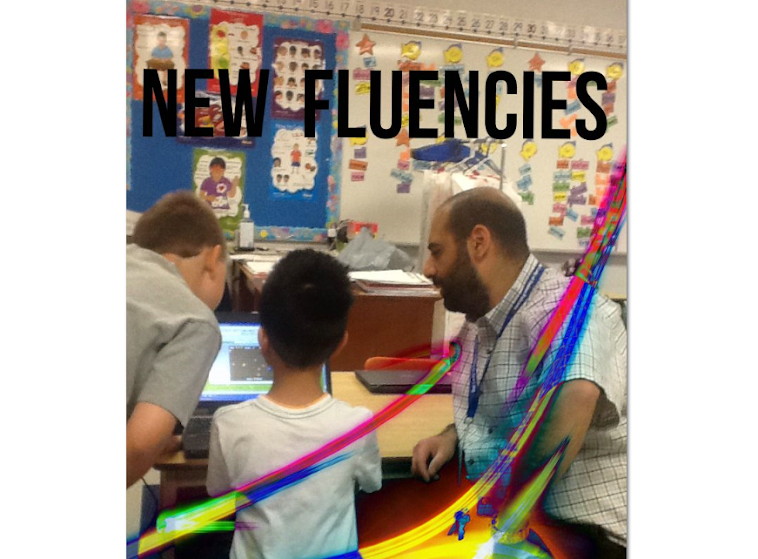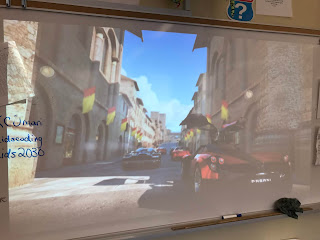A few months ago I dove into esports when I took a course called "
Build a school to career pipeline with esports and gaming concepts" through the
Microsoft Educator Community. It was a good course - quite informative with respect to what esports is, what it looks like in an educational setting, and how to get started (high school and above). My only issue with the course was that it didn't get into esports or gaming concepts with younger students. Having integrated video games into the learning of primary students in the past, I was surprised that there wasn't much on that in the course.
In 2012 I learned about a teacher in the UK who was using video games with students to help them improve their writing.
David Andrews was integrating the use of technology (iPads) and video games to help engage his students in the writing process and to help them improve their writing. At the time, I thought that I could have used what David was doing with the last class I taught - a large group of boys who disliked writing very much. Based on his results and consultations with him, I decided to try implement some of what what he had done to help my students along with their writing process and skills. I ended up writing a series of blog posts about the experience. Feel free to check them out here:
part #1,
part #2, and
part #3.
Seven years later and I find myself interested and intrigued with competitive and organized video gaming and how it can be integrated into the curriculum - especially with primary students. One of the reasons that esports is so popular is because a lot of kids play video games - and are good at them. From a global perspective, millions of people around the world tune in to esports events that are streamed online. The fact that
"27 Million people watched the League of Legends Championship in 2017 [*more than Game 7 of the World Series (23.5 million) and the final game of the NBA Finals (18 million)]." is mind blowing.
"Projections are that over 589 million people will watch esports by 2020.".
Based on the growing popularity of esports, how much kids love to play video games (generally speaking), my enjoyment of video games, and the opportunity to increase student engagement and achievement (academic, social, and emotional) by integrating esports into the curriculum, I decided that I wanted to bring it into my classroom. I started by looking online to see what I could find regarding esports with primary students. I didn't find anything. I went to Twitter next and I found the #esportsedu community which is strong and growing larger each day. I was looking for a model or a template that would help me integrate esports into my grade 3 classroom and hoped that I would find that within the #esportsedu community but I didn't find any such thing. I did find people like
@chomoojoo,
Mike Washburn, and
Steve Isaacs who have been helpful and supportive. So much so that I decided to blaze my own trail based on my interactions with them.
After communicating with them, and thinking about how I wanted to get started, I decided that I wanted to find a game that would be competitive, accessible to my students (free, online, and easily played on a chromebook), and be connected to the curriculum. I went to the
Cool Math Games website and started searching. I found
Moto X3M - a cool motorcycle game that involves passing levels. At the end of each level, the students are informed how long it took them to complete the level. BINGO! I found a game I could use. Let me explain.
I introduced the idea of esports to the students. They were interested, actually they were pretty excited that they were going to get to play video games in class. I introduced them to the game and told them that their goal was to complete the first level as fast as possible and that I would give all of them 15 minutes to practice. In order to make it easy for the students to get to the game, I grabbed the link and put it in our D2L class site for easy access.
The competition would involve three rounds. In the first round, all the students would have the opportunity to compete. The top ten finishers would move on to the second round. In the second round, the top five finishers would move on to the third round. In the third round the first, second, and third place finishers would be identified.
After the first round, each student had to read their number to me. Up to this point we had only worked with whole numbers - this would be a great opportunity to talk about the decimal and the continue our talk about place value. After each round the students were responsible for comparing and ordering the finish times, which connects with the work we had just formally finished up with respect to Number Sense and Numeration. The opportunity to spiral our mathematics is welcome as it provides the students with points of reference with which they can refer to as they continue to learn. In this instance they could make connections to what they had already learned in math and moving forward they can look back on this esports activity to connect to the 'new' math they will be learning in the future.
Take a look at the data we collected. I recorded the times as they were brought to my attention. The students had to work to compare and order the times. They asked me to highlight certain times but didn't ask me to create a new chart to order them.
The students that were eliminated from the competition worked on improving their times but would stop and work with the rest of the students to compare and order times after each round. At the end of this competition we talked about the experience and whether they would like to do it again. All of the students indicated that they wanted to participate in esports and even had suggestions on what games we could use to compete.
This was a really fun experience. Although the math was a bit challenging, it didn't seem to scare any of the students away. What I was seeing and hearing as they were comparing and ordering the times was great formative assessment data for me. I could see which students were able to do the activity with ease, who struggled, and everything in between. This activity also allowed me to take a look at some of the learning skills like initiative, collaboration, and organization. After all was said and done we took time to reflect on what the students could do to improve their times with respect to this game. Here were their responses:

In terms of next steps I would like to continue to find games that will allow students to compete and that I can connect to the curriculum. At first sight and thought, I can make quick connections between esports and the Language curriculum. I also see how these types of activities can benefit students with respect to "assessment AS learning" experiences. The Global Competencies and Catholic Graduate expectations need to be considered as well as I move forward with this in a more organized fashion. I would also like to move the esports out of classroom time and into recess time as an extra curricular activity. I think it would be a great option for the students who like to play video games and compete. I am also interested in using a console gaming system like a PS3 or Xbox where students can compete 'head to head' in true tournament fashion with traditional sports games like hockey and soccer.
I think that my students and I did a pretty good job for our first esport activity. With no model or template I took what I had learned about esports so far and put it into action in order to get the ball rolling and start my learning journey and how I can help my students improve their achievement in a number of different areas.
I would love to hear from you. If you have any questions or comments, please feel free to leave them in the comments.































